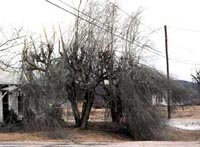Resource Library
Plant of the Week: Siberian Elm
The University of Arkansas System Division of Agriculture does not promote, support or recommend plants featured in "Plant of the Week." Please consult your local Extension office for plants suitable for your region.
Plant of the Week
Siberian Elm
Latin: Ulmus pumila

I grew up in Oklahoma so one of my favorite sayings used to be "I never met a tree
I didn’t like -- except for the Siberian elm." I guess I’ve mellowed because now I
even like Siberian elms. Don’t get me wrong -- it is truly a dreadful tree with almost
no redeeming features -- except for its toughness.
Siberian elm grows up to 60 feet tall and 40 feet wide. Older trees have gray trunks
with somewhat weeping branches and an open habit of growth. The tree is very fast
growing. Its wood is brittle and very susceptible to breakage in ice storms. Branches
are twiggy with dark green leaves up to 2 1/2 inches long that look like the typical
elm leaf.
Some argue this tree would have been best left in the cold wastes of Siberia but
the story of how it got here and why it is so common today is part of the tree’s "charm."
At the beginning of this century the federal government, namely the U.S. Department
of Agriculture and its Bureau of Plant Introduction, embarked on a series of plant
collecting trips to the far corners of the world to bring back useful plants. One
of their most successful plant explorers was Frank Meyer (1875-1918). Meyer made four
extended trips into the Far East, including a two-year swing through Siberia. There
he collected hardy forms of alfalfa, clovers, fruits and our friend, the Siberian
elm. In addition to this elm and many other woody plants, Meyer is remembered today
for his introductions of soybeans which helped establish the American soybean industry,
for Meyer’s zoysiagrass and the ubiquitous Bradford pear. He died under mysterious
circumstances while in China seeing to the collection of pear seeds.
Meyer’s Siberian elm finally made it to Mandan, N.D., where Lewis and Clark overwintered
on their voyage of discovery, and the USDA maintains an experiment station. The tree
flourished in that climate, and then, as the song says, the Depression and Dust Bowl
blew in like a cold northern wind. USDA scientists began looking for plants that would
serve as a wind break and grow in the dry, brutal climate that existed during the
30s in the Great Plains. The Siberian elm fit the bill, as it was fast growing and
would grow almost anywhere.
Once the tree was widely planted, its flaws became readily apparent. The biggest
of these is elm leaf beetle, which shreds the leaves each summer and turns the foliage
brown by August. Its susceptibility to ice storm damage also showed up early.
Otherwise, the tree is tough as nails and is now common throughout the country. In
the 1950s it began to be sold nationwide on the back of the Sunday paper magazine
section as a hedge plant to replace privet. This must be one of the worst horticultural
ideas of all time, yet hundreds of thousands of trees were sold and it spread to all
corners of the U.S.
The tree is resistant to Dutch elm disease so it has been used in breeding programs
to produce disease resistant selections such as the Urban and Regal elms which are
occasionally met with in the trade. Unfortunately, these hybrids are also fodder for
the elm leaf beetle. The perfect plant does not exist, and certainly the Siberian
elm resides far from the mark of perfection, yet this tough plant is a part of our
great American plant community and may yet find places where its virtues can be appreciated.
By: Gerald Klingaman, retired
Extension Horticulturist - Ornamentals
Extension News - January 8, 1999
The University of Arkansas System Division of Agriculture does not maintain lists of retail outlets where these plants can be purchased. Please check your local nursery or other retail outlets to ask about the availability of these plants for your growing area.